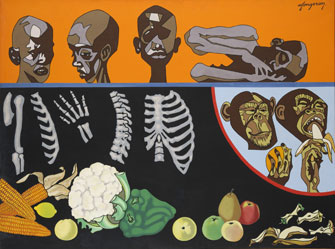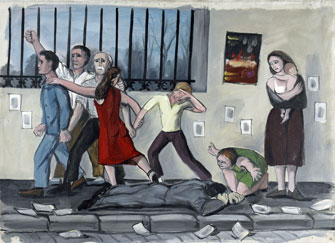The Paradoxes of a
Committed, Electric Artist

“Tableau Noir” (1983), by André Fougeron. Photo: A. Leprince. © ADAGP Paris 2014
At a time when modern art was moving toward abstraction, the French artist André Fougeron remained firmly anchored in social realism, assiduously chronicling the history of his day in figurative paintings that can be appreciated at an exhibition now showing at La Piscine, a museum in the northeastern French city of Roubaix, near Lille.
Until recently, Fougeron had been more or less forgotten in France, although, perhaps surprisingly, the Tate Modern in London dedicated a whole room to him at its opening in 2000. The show at La Piscine aims to remedy that neglect, offering a retrospective of his entire career from its beginnings in 1937.
Fougeron was born in 1913 into a laborer’s family in the Creuse, in central France. He began his working life as a metal worker and only started painting in 1936. Self-taught, he drew inspiration from his political engagement as a member of the Communist Party in the glory years of France’s left-leaning Popular Front government, between the two world wars, and remained faithful to Communism until his death in 1998.
War and its atrocities were constantly recurring themes in his paintings and posters throughout his artistic life, among them the Spanish Civil War, the Nazi occupation of France, the Vietnam War and the war in Algeria – no shortage of upheavals to choose from. Active in the Resistance during the occupation, he used his studio as a clandestine printing press.
As an artist, he took an independent path. Eschewing the escapist abstractionism through which more intellectual artists avoided the moral dilemmas of the war years, he incarnated a politically engaged “new French realism.”
He was, however, influenced by the artistic trends of the time, using the techniques of Surrealism, Cubism, Pop Art and Neoclassicism in paintings that focused on the underbelly of history, representing the elderly, the oppressed, victims, laborers and the simply exhausted. In one of his finest paintings, “Cuisinière Endormie” (1947), a woman sits slumped, asleep at a table, surrounded by fruit peelings and a colander of quinces. A still life, near death.
The show includes some 170 works, mainly paintings but also posters, drawings and ceramics. What shines through is the artist’s extraordinary technical mastery and stylistic

“Hommage à André Houllier” (1949), by André Fougeron. Photo: A. Leprince. © ADAGP Paris 2014
eclecticism, put to the service of a passionate engagement that is sometimes cruel and sometimes fiercely erotic. Work from the Spanish Civil War years includes an extraordinary drawing, “Disemboweled Horse, Attacked by Boars.”
Among the paintings from the 1970s are deeply equivocal but undeniably voluptuous nudes, depicted as objects of male ownership: in “Property Is Theft, or Kaulbach’s Servant’s Thighs” (1976), a reclining nude is seen from the rear, her body surrounded by the faces of a group of bourgeois men.
How Fougeron came to be overlooked for so long is a mystery, however uncomfortable a presence he clearly was. This exhibition at the Piscine is a serious attempt to give him the place he deserves in the history of modern French art. (The setting, a former swimming pool with a stunning Art Deco structure and interior, is worthy of the enterprise and is worth a visit in its own right.)
Bruno Gaudichon, one of the curators of the exhibition and director of La Piscine, noted that “Fougeron represented an image of his time, but at the same time has no image, since we don’t know his work. That is the paradox.”
La Piscine: 23, rue de l’Espérance, 59100 Roubaix. Tel.: 03 20 69 23 60. Open Tuesday-Thursday, 11am-6pm; Friday, 11am-8pm; Saturday-Sunday, 11am-6pm. Closed Monday and May 1. Admission: €9. Through May 18.
Reader Michael Barker writes: “La Piscine at Roubaix, built 1927-32, is Art Deco not Art Nouveau, a style which had virtually died out well before 1914 (even though it lingered on with rather tired late works of Guimard in Paris and some in Spain and in Italy). The roots of Art Deco can be traced back to as early as 1903 – the avant-garde construction in Rue Benjamin-Franklin, Paris, by the builder-architect Auguste Perret and the Palais Stoclet in Brussels are two notable examples of a new modernism – albeit the actual coining of ‘Art Deco’ to designate the style did not appear until the 1960s.”
Reader reaction: Click here to respond to this article (your response may be published on this page and is subject to editing).
Please support Paris Update by ordering books from Paris Update’s Amazon store at no extra cost. Click on your preferred Amazon location: U.K., France, U.S.
More reviews of Paris art shows.
© 2014 Paris Update
Favorite